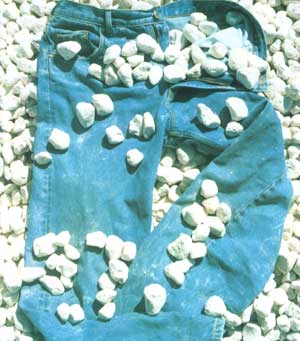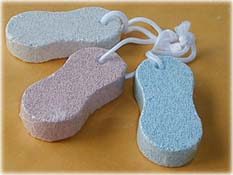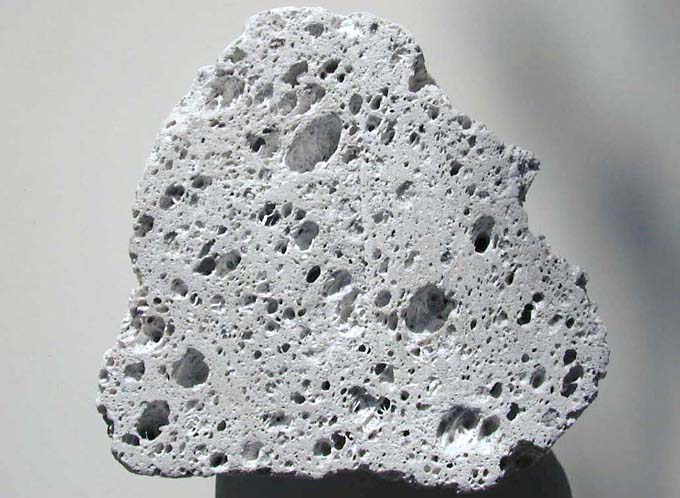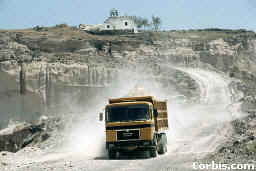- Index
-
- About
-
- Marketing
-
- Articles
-
- VrijeUniv.
-
- Turkey
-
- Colaturka
-
- Pumice
-
- Business
-
- Links
| |

-
- Background
-
- Pumice is a type of extrusive volcanic rock, produced when lava with
a very high content of water and gases is extruded (or thrown out
of) a volcano. As the gas bubbles escape from the lava, it becomes
frothy. When this lava cools and hardens, the result is a very light
rock material filled with tiny bubbles of gas. Pumice is the only rock
that floats on water, although it will eventually become waterlogged and
sink. It is usually light-colored, indicating that it is a volcanic rock
high in silica content and low in iron and magnesium. If the lava
hardens quickly with few volatiles, the resulting rock is volcanic glass.
Pumice and obsidian are often found together.
-
- In commerce, pumice is the term applied to larger pumice
stones, while pumicite consists of fine grains or ash. Pozzolan
is a fine-grained pumicious material (both natural and man-made), which
combines with lime to make a smooth, plaster-like cement. These three
similar materials may be found and mined together, but they have
different characteristics and different uses.
-
-
|
 -
- Achtergrond
-
- Puimsteen is een soort vulkanische rots, geproduceerd, wanneer lava met een heel hoge inhoud van water en gassen zijn uitgeknepen (of
weggeslingerd uit) een vulkaan. Wanner het gas ontsnapt uit de lava, wordt het
schuimend. Wanneer deze lava, afkoelt, is het resultaat een heel licht rots materiaal, dat met minuscule bellen van gas gevuld wordt. Puimsteen is de enige rots dat
drijft op water, hoewel het uiteindelijk volloopt met water en
zinkt. Het is gewoonlijk licht-gekleurd, aanduidend dat het een vulkanische rots is, die
een hoog siliciumdioxide-gehalte heeft en en laag ijzer en
magnesium-gehalte heeft. Indien de lava vlug ver hardt, is de resulterende rots vulkanisch glas. Puimsteen en
obsidiaan zijn samen dikwijls gevonden.
- In de handel wordt de term puimsteen gebruikt voor de grotere
brokken steen wordt, terwijl pumicite voor fijne graankorrels of as
wordt gebruikt. Pozzolan is een fijn gekorreld puimsteen-achtig materiaal (zowel natuurlijk als kunstmatig),
waarmee met kalk gecombineerd een glad cement te maken is. Deze drie
gelijksoortige materialen zullen misschien gezamenlijk gevonden worden, maar zij hebben verschillende kenmerken en verschillende
gebruiksdoelen.
-
|
 -
- Background
-
- Pumice is a type of extrusive volcanic rock, produced when lava with
a very high content of water and gases is extruded (or thrown out
of) a volcano. As the gas bubbles escape from the lava, it becomes
frothy. When this lava cools and hardens, the result is a very light
rock material filled with tiny bubbles of gas. Pumice is the only rock
that floats on water, although it will eventually become waterlogged and
sink. It is usually light-colored, indicating that it is a volcanic rock
high in silica content and low in iron and magnesium. If the lava
hardens quickly with few volatiles, the resulting rock is volcanic glass.
Pumice and obsidian are often found together.
-
- In commerce, pumice is the term applied to larger pumice
stones, while pumicite consists of fine grains or ash. Pozzolan
is a fine-grained pumicious material (both natural and man-made), which
combines with lime to make a smooth, plaster-like cement. These three
similar materials may be found and mined together, but they have
different characteristics and different uses.
|
- Name
-
- The name pumice is derived from the Latin word pumex, meaning
foam. Pozzolan (or pozzolana) is an Italian word, named from
Pozzuoli, the place near Naples where pozzolan was first mined and used
as cement, during Roman times.
-
-
|
- Naam
De naam puimsteen is van het Latijn woord pumex afgeleid, wat schuim
betekent. Pozzolan (of pozzolana) is een Italiaans woord, afkomstig van Pozzuoli, de plaats
vlakbij Naples waar pozzolan als eerst gedolven was en gebruikt werd als cement,
ten tijde van de Romeinen.
|
- Name
-
- The name pumice is derived from the Latin word pumex, meaning
foam. Pozzolan (or pozzolana) is an Italian word, named from
Pozzuoli, the place near Naples where pozzolan was first mined and used
as cement, during Roman times.
|
- Sources
-
- Since pumice is a volcanic rock, and retains its useful properties
only when it is young and unaltered, pumice deposits are found in areas
with young volcanic fields. Worldwide, over 50 countries produce pumice
products. The largest producer is Italy, which dominates pozzolan
production and also produces some pumice. Other major pumice producers
are Greece, Chile, Spain, Turkey, and the United States.
- In the United States, Arizona, California, New Mexico and Oregon are
the major producers of pumice, accounting for the majority of the
nationís pumice and pumicite production.
|
- Bronnen
Aangezien puimsteen een vulkanische rots is en zijn nuttige
eigenschappen alleen behoudt wanneer het vers en onveranderd is, is puimsteen
te vinden in gebieden met jonge vulkanische velden. Wereldwijd wordt
er in 50 landen puimsteenproducten geproduceerd. De grootste producent is ItaliŽ, welk pozzolan vervaardiging domineert en ook
puimsteen produceert. Andere belangrijke puimsteen producenten zijn Griekenland, Chili, Spanje,
Turkije en de Verenigde Staten.
In de Verenigde Staten zijn Arizona, CaliforniŽ, Nieuwe Mexico en Oregon de belangrijke producenten van puimsteen,
goed voor de meerderheid van de puimsteen en pumiciteproductie.
|
- Sources
-
- Since pumice is a volcanic rock, and retains its useful properties
only when it is young and unaltered, pumice deposits are found in areas
with young volcanic fields. Worldwide, over 50 countries produce pumice
products. The largest producer is Italy, which dominates pozzolan
production and also produces some pumice. Other major pumice producers
are Greece, Chile, Spain, Turkey, and the United States.
- In the United States, Arizona, California, New Mexico and Oregon are
the major producers of pumice, accounting for the majority of the
nationís pumice and pumicite production.
|
- Uses
-
- Pumice and pumicite are used to make lightweight construction
materials such as concrete block and concrete. About three-quarters of
pumice and pumicite is consumed annually for this purpose.
- The remainder of the pumice mined is used in abrasives, horticulture,
landscaping, and for washing blue jeans.
- Pozzolan is used to make fine-grained, lightweight cement for
finishing floors and building interiors.
-
|
- Gebruiksdoelen
Puimsteen en pumicite wordt gebruikt om licht bouw materialen te
maken zoals beton. Ongeveer driekwart van de puimsteen wordt jaarlijks
hier voor gebruikt.
De rest is van de puimsteen wordt gebruikt voor schuurmiddelen, de
tuinbouw, landschapsarchitectuur en voor het wassen spijkerbroeken
e.d.
Pozzolan wordt gebruikt om licht cement te maken om vloeren mee te
polijsten en voor de binnenhuisarchitectuur.
|
- Uses
- Pumice and pumicite are used to make lightweight construction
materials such as concrete block and concrete. About three-quarters of
pumice and pumicite is consumed annually for this purpose.
- The remainder of the pumice mined is used in abrasives, horticulture,
landscaping, and for washing blue jeans.
- Pozzolan is used to make fine-grained, lightweight cement for
finishing floors and building interiors.
|
- Substitutes and Alternative Sources
-
- Expandable shale can be substituted for pumice and pumicite in the
building block and concrete applications. There is no lack of pumice and
pumicite, as world resources are extensive. However, the costs related
to mining and trucking the material from the mine to processing plants
and the market will determine whether pumice from a particular mine is
cheap enough to use. In other words, it is economics, not the abundance
of pumice, which determines whether or not substitutes for pumice are
necessary.
-
- Source: Mineral Information Institute,www.mii.org
|
- Vervangingsmiddelen en Alternatieve Bronnen
Uitzetbare leisteen kan vervangen worden door puimsteen en pumicite in de bouwsteen en
beton toepassingen. Er is geen tekort aan puimsteen, omdat de
bronnen uitgebreid zijn. Echter of puimsteen van een bepaalde mijn
goedkoop genoeg is en de kosten m.b.t. de mijnbouw en de transport
van het materiaal zal door de markt vastgesteld worden. Met andere woorden is het
de economie en niet de overvloed van puimsteen, wat bepaalt of
vervangingsmiddelen voor puimsteen noodzakelijk zijn.
- Bron: ineral Information
Institute, www.mii.org
|
- Substitutes and Alternative Sources
-
- Expandable shale can be substituted for pumice and pumicite in the
building block and concrete applications. There is no lack of pumice and
pumicite, as world resources are extensive. However, the costs related
to mining and trucking the material from the mine to processing plants
and the market will determine whether pumice from a particular mine is
cheap enough to use. In other words, it is economics, not the abundance
of pumice, which determines whether or not substitutes for pumice are
necessary.
-
- Source: Mineral Information
Institute, www.mii.org
|
 |
<<Pumicite |
 |
<< Use in Jeans industtry |
 |
<<Feet care |
| Pumice>> |
 |
Health care>> |
 |
Delving plant>> |
 |
 |
<<Pumice |
 |
<<Pumice Brush |
 |
<<Delving plant |
|
|
|
|
|
|
|
|
|
|
|
|
|
|
|
|
|
|
-
|
![]()